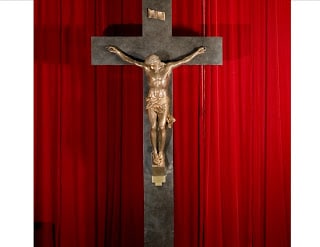In just a few more hours, the Church will begin the solemn three-day celebration officially known as the Sacred Paschal Triduum of the Death, Burial and Resurrection of the Lord, or simply the Triduum. The Pauline liturgy’s Paschal Triduum of Friday, Saturday, and Sunday (beginning the evening before with the Solemn Mass of the Lord’s Supper on Thursday and concluding with Evening Prayer on Sunday) replaces the older medieval Sacred Triduum of Thursday, Friday, and Saturday (which began with Tenebrae on Wednesday afternoon/evening and concluded with pro-Vespers at the end of the « Easter Vigil » celebrated on Saturday morning).
The Triduum reflects the likely more accurate Johannine chronology, according to which Jesus was crucified on Nisan 14, the Preparation Day before the Passover, which began at sundown after Jesus’ burial. The traditional liturgy’s reading of John’s Passion on Good Friday, preceded by Exodus 12:1-11 highlighted the salvific symbolic significance of Christ’s death on Preparation Day and his identification with the Paschal lamb. Chronologically, then, Jesus, knowing that his hour had come [John 13:1], that he would be already dead by the time of the Passover ands would in fact never again celebrate the old Passover, anticipated the festival with a uniquely new Christian reconfiguration of the ritual meal at the Last Supper which has since become the Lord’s Supper.
Chronological considerations aside, the Triduum is more than an historical commemoration – much less a theatrical reenactment of the great drama, as Christ were not already risen and reigning at his Father’s right hand and we were instead waiting for something new to happen on Easter Sunday. It is the Risen Christ we celebrate these days – as we do every day. It is the Risen Christ whom we will receive in the Eucharist tonight, not the historical Jesus at the Last Supper nor tomorrow the dead and buried Jesus of Good Friday. The Triduum is, of course, an invitation to contemplate Christ’s death and burial before celebrating his resurrection in order to identify with his death and burial so as to enter fully into the benefits of his resurrection.
The Triduum is, finally, the ritual reception of Christ’s revelation of who he is and, therefore, who God is. We commemorate the Incarnation at Christmas, but we experience its fuller meaning and relevance for us in this Triduum. For God, as Hebrews says, in these last days having now revealed himself to us by his Son, we now experience and understand in an altogether new way, which would hav been impossible apart from Jesus, who God is and how God is for us. As Romano Guardini wrote long ago in his famous work The Lord, « What Christ did, God did. What Christ suffered, God suffered. The Father rejected not part of the life of his Son » [tr. Elinor Castendyk Briefs, Gateway, 1954].
We should glory in the Cross of our Lord Jesus Christ, in whom is our salvation, life, and resurrection, through whom we are saved and delivered [Entrance Antiphon, Mass of the Lord’s Supper].
Photo: « Hewit Crucifix, » Saint Paul the Apostle Church, NY, 2010.





